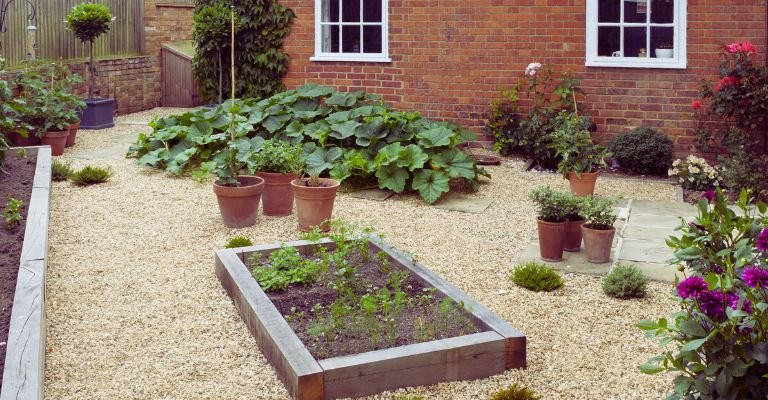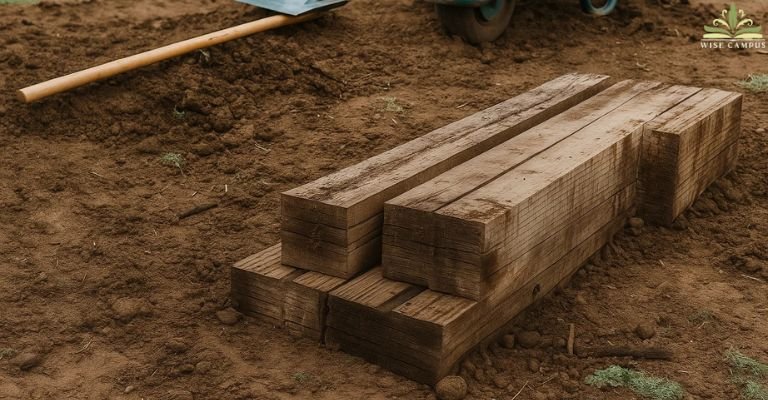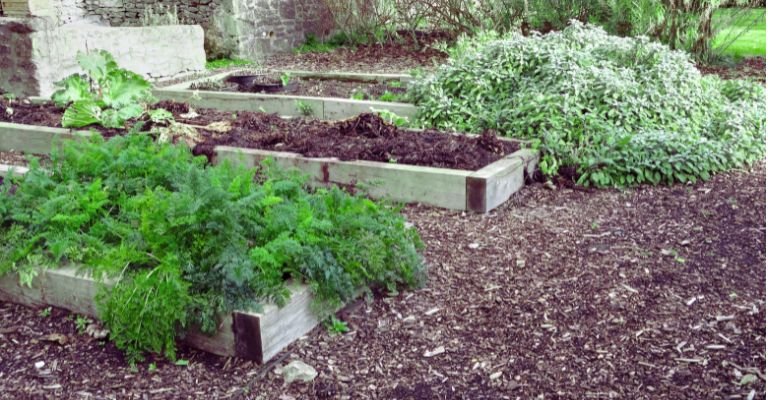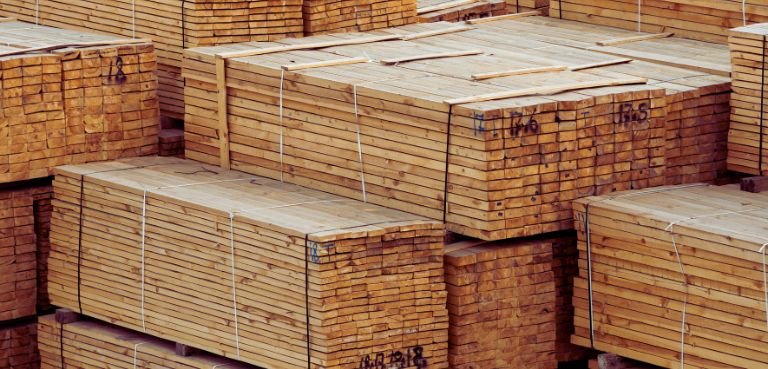No products in the cart.
If you want a garden that looks great and stays easy to manage, garden designs using sleepers are the way to go. Sleepers give you strong edges, neat steps, raised beds, and even seating in no time.
Sleepers are not just useful, they’re fun to work with. You can build raised beds in minutes, design paths or steps that last, and even create benches for family and friends to enjoy. When you mix sleepers with gravel, you get both beauty and function. Gravel keeps the look clean, highlights the timber’s natural warmth, and makes maintenance simple.
With just a little planning, you can turn any outdoor space into something neat, welcoming, and full of character. Start small, build your confidence, and soon you’ll have a garden you’re proud of.
What Are Sleepers?

Sleepers are sturdy pieces of timber used to give gardens structure and style. You can choose new or reclaimed timber depending on your budget and look. New sleepers look clean and fresh, while reclaimed ones have a weathered, rustic charm.
Common sizes include 200×100 mm, which work well for most garden projects. You can use sleepers for many purposes. For example, they create strong frames for raised beds, steps, garden edging, and even simple seating.
Because sleepers are versatile, you can mix and match them with gravel or plants. This approach gives your garden both structure and a modern rustic style without much fuss.
Why Use Sleepers in Garden Design
- Instant structure – give your garden clear edges, steps, and raised beds quickly.
- Natural look – timber blends perfectly with plants and gravel.
- Budget-friendly – cheaper than stone, yet strong and long-lasting.
- Easy to DIY – simple to cut, place, and adjust yourself.
- Perfect for slopes – create terraces or steps without heavy construction.

Design Ideas That Always Work
Here are some garden ideas using sleepers and gravel that always look great and stay practical. Mix and match these ideas to suit your space and style.
- Raised veg & herb beds – tidy rectangles let you reach plants easily from both sides. You can add gravel paths around them for cleaner access.
- Gravel paths with sleeper edging – sleepers keep stones in place and define clear walkways. Add curves for a softer, natural look.
- Sunken seating nook – low sleeper edges act as benches and retaining walls. Scatter cushions for comfort and a cosy vibe.
- Terraced levels on a slope – shallow risers create planting pockets and help control water flow. Plant herbs or flowers between terraces.
- Fire-pit surround – sleepers form a heat-safe border with a gravel base. Perfect for evening chats and marshmallow roasting!
- Pond or rill frame – timber borders create neat water features without concrete. Add gravel and rocks to blend naturally.
- Play zone edging – sleepers keep bark, sand, or soft play surfaces in place. Ideal for a tidy, safe kids’ area.
- Pergola posts on sleeper plinths – sturdy bases for pergolas or garden arches. You can even plant climbers around them.
- Feature steps – 150–180 mm risers with gravel treads look natural. Use them to connect terraces or lead to a seating area.
- Front-garden borders – raise soil levels to create height for statement planting. Gravel paths or small sleepers can define the edge.
With sleepers and gravel, you can combine structure, style, and practicality. They give your garden a rustic yet modern feel, keep maintenance low, and let you experiment with fun layouts. Start small, try one feature, and gradually add more — your garden can grow with your creativity!
Choosing the Right Sleepers: Looks, Longevity, and Cost
Picking the right sleepers makes a big difference in your garden’s style, durability, and budget. Let’s explore your options.
New pressure-treated softwood is budget-friendly and looks uniform. It’s easy to cut and install, so perfect for DIY projects.
Hardwood sleepers are more expensive but last much longer. They give your garden a premium, sturdy feel that ages beautifully. Reclaimed sleepers can add charm and character. However, avoid tar-soaked railway sleepers near vegetables or herbs because chemicals can leach into soil.
Think about your garden’s style, how long you want it to last, and your budget. A little planning now saves hassle later and keeps your outdoor space looking great.
Ground Prep That Prevents Sinking

A little prep goes a long way when building with sleepers and gravel. First, remove any turf so the area is clear. Next, level the ground lightly to make surfaces even and neat.
Where people will walk or drive, compact a sub-base to stop sleepers or gravel from sinking over time. Then, under all gravel areas, lay a permeable membrane. This keeps weeds at bay while letting water drain naturally.
With these simple steps, your garden stays tidy, stable, and easy to maintain. Plus, it makes installing sleepers and gravel much more fun and stress-free!
Fixing & Joining Sleepers (So It Stays Square)
To make your sleepers stay strong and neat, a few simple steps go a long way. First, pre-drill your timber to avoid splitting. Next, use exterior coach screws or plates on corners to hold everything firmly in place.
If you’re stacking sleepers, stagger the joints like bricks for extra stability. For long runs, peg or drive rebar through the sleepers so they don’t shift over time.
These small steps keep your garden structure straight and safe. Take your time, and soon your raised beds, steps, or borders will look tidy, solid, and last for years.
Finishes & Colours
Finishing your sleepers is a great way to add style and personality to your garden. Consider these tips:
- Leave to silver naturally – gives a weathered, rustic look that blends with plants.
- Use oil or stain – adds a warmer, richer tone for a cosy feel.
- Match gravel and fence colours – creates a joined-up, harmonious appearance.
- Small touches count – even subtle colour choices make your garden feel stylish and inviting.
With these simple points, your sleepers will be both practical and visually striking, giving your garden a polished, finished look.
Planting With Sleepers

Sleepers aren’t just for structure—they also create perfect planting frames that make your garden look full of life. They’re ideal for raised beds, edges, or terraces, and they help define spaces clearly while giving plants room to grow.
Here’s how to make the most of sleepers in your planting:
- If your garden gets plenty of sun, go for grasses, lavender, thyme, or salvia. They bring colour, lovely scents, and a bit of movement to your space.
- Shade-friendly plants – ferns and hostas work well in shady corners, creating lush, green zones.
- Keep it simple – stick to a few plant types to avoid a cluttered look.
- Repeat for calm – repeat colours, textures, or plant shapes across your garden for a cohesive, peaceful feel.
- Add height and texture – mix tall and low-growing plants to create depth and interest.
- Seasonal touches – include a few flowering plants that bloom at different times to keep your garden looking lively all year.
Using sleepers for planting lets you combine structure and greenery seamlessly. You get a garden that’s neat, easy to maintain, and full of character. With a small planning, your raised beds and edges can be both functional and beautiful, making each corner of your garden inviting and beautiful.
Maintenance Made Simple
Keeping your sleepers and gravel garden looking great is easier than you think. Just a little care goes a long way!
Start with an annual check for loose screws or fixings. Then, if you like a richer timber colour, give your sleepers a quick oil treatment. Rake the gravel to keep it tidy and level, and trim edges to maintain neat borders.
That’s really all it takes! With these small steps, your garden stays structured, stylish, and low-maintenance. Plus, it’s satisfying to see your hard work pay off year after year.
Garden Design Using Sleepers: Safety & Sustainability
When building your garden, safety and sustainability matter. Garden design using sleepers and gravel can be stylish and eco-friendly if you follow a few simple rules.
Always use FSC-certified timber to support sustainable forests. Always wear gloves and eye protection when cutting or drilling sleepers. Keep the timber away from damp walls to stop it from rotting. Avoid using creosote-treated sleepers in vegetable or herb beds to keep your food safe. And make sure gravel areas stay permeable so rainwater can drain away naturally.

By taking these steps, you make your garden safe, sustainable, and long-lasting, while keeping it neat and low-maintenance. Plus, it’s satisfying to know your garden is friendly to both people and the planet!
Pets & Kids: Smart Tweaks for Safe Fun
Designing your garden for pets and kids keeps everyone happy and safe. Round over sharp sleeper corners to prevent bumps. Use rounder gravel so paws and little feet don’t hurt.
Leave a hard strip for scooters, bikes, or trikes to avoid muddy paths. Place benches away from ball zones so seating stays comfortable and damage-free.
With these simple tweaks, your garden stays fun, safe, and practical. Everyone can enjoy it, from playful pups to energetic kids, without constant worry.
Installation Tips: Beginner-Friendly Pacing
Installing sleepers and gravel is easier if you take it step by step.
- Set the first row level – this gives your garden a strong, stable base.
- Check corners and edges – make sure everything stays square as you go.
- Keep paths 80–100 cm wide – comfortable to walk on and easy to maintain.
- Let water drain – avoid low spots where puddles can form.
- Build gradually – add one layer at a time and keep checking alignment.
- Step back often – look at your progress to spot any adjustments early.
By following these steps, even beginners can create a tidy, stylish, and long-lasting garden with sleepers and gravel.
Cost & Sourcing
Planning costs carefully helps your garden look great without breaking the bank. Spend wisely on sub-base, fixings, and edging—they are essential for strong, lasting structure.
You can save on fancy gravels or decorative stones without losing style. Always buy a little extra timber and stone so you can match materials later if needed.
With smart sourcing, your sleepers and gravel garden stays budget-friendly, practical, and stylish. Plus, it reduces stress when building and maintaining your outdoor space.
FAQs
1. What is the best base for garden sleepers?
- For steady sleepers, use a solid base like concrete, gravel, or hardcore. Sand works too, but gravel or hardcore is easier and popular.
2. What is the cheapest way to edge your garden?
- The cheapest way to edge your garden is with plastic or rubber materials.
3. Do garden sleepers attract pests?
- Using railway sleepers with mulch can attract termites, creating a risk for your home. It’s safer to avoid this combination entirely.
4. Can you lay sleepers directly on soil?
- You can place sleepers directly on soil, but it’s not ideal. Moisture can cause rot, and soil movement can make them uneven.
5. How to make sleepers look nice?
- Make sleepers look good by oiling or staining, sanding edges, and pairing them with gravel or plants.
Ready to Transform Gardens Like a Pro?
Why just dream about beautiful outdoor spaces when you can design them yourself? Our Landscape Gardening Course gives you the skills, confidence, and know-how to create stunning gardens.
Enrol today and start turning your passion for gardening into a real skill (and even a career!).







